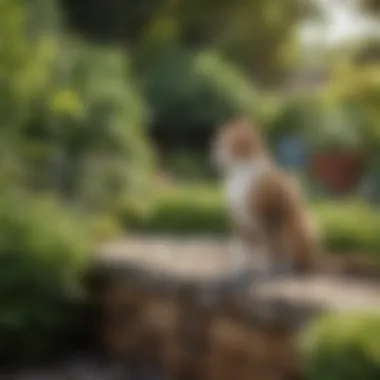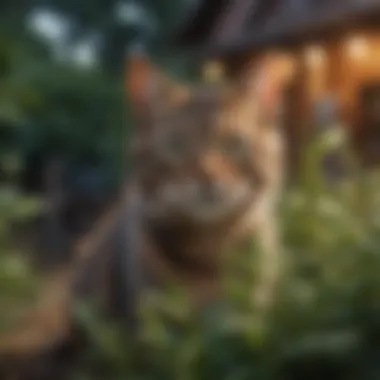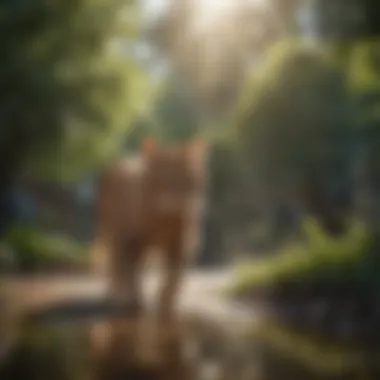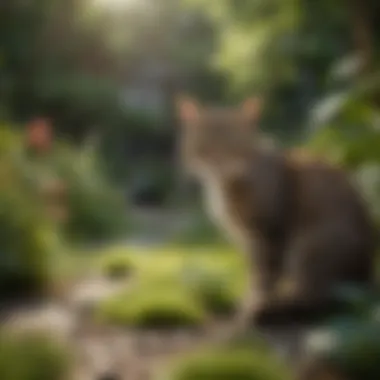Effective Strategies for Keeping Cats Out of Your Garden


Intro
Keeping cats away from gardens is a relevant concern for many gardeners. Understanding cat behavior can help inform effective strategies. This article covers various methods to deter cats while promoting wildlife welfare.
A cat’s natural instincts often lead them to gardens. They may see it as a play area or a hunting ground for small creatures. With a thoughtful approach, gardeners can protect their plants without harming these animals.
Next, we will explore some fascinating facts about cats. This understanding can aid gardeners in navigating their coexistence with these creatures effectively.
Fascinating Facts About the Animal
Unique Characteristics
Cats, scientifically known as Felis catus, possess intriguing traits. They have a flexible skeletal structure, allowing them to squeeze through tight spaces. Their excellent night vision enables them to navigate in low light. Additionally, cats have a strong sense of smell, which plays a role in their behavior.
These characteristics are essential for understanding how to keep them away from gardens. Knowing what attracts them can help in implementing suitable deterrents.
Extraordinary Abilities
Cats are agile hunters. They can leap up to six times their body length. This ability allows them to access various areas, including your garden, quite easily. Moreover, their acute hearing can detect even the faintest sounds, making them proficient in locating prey such as small rodents.
Recognizing these abilities underscores the need for effective barriers or repellents to ensure gardens remain untouched.
Behavior and Habitat
Natural Habitats
Domesticated cats are often found in urban and rural areas. They adapt to varying environments, from city streets to quiet suburbs. Their preference for sunny spots makes gardens particularly attractive.
Social Structures
Cats are generally solitary animals but can form social groups. This behavior can influence their visits to gardens. During mating seasons, strays may venture into gardens more frequently, making it crucial for gardeners to stay alert.
Recent Scientific Discoveries
Latest Research Findings
Studies have revealed that cats can be sensitive to certain scents. There is emerging data showing how certain commercial repellents work. Understanding these findings can guide the choice of products used in gardens.
Breakthroughs in Animal Biology
Advancements in animal behavior research highlight the emotional lives of cats. They experience stress and anxiety, similar to humans. This knowledge can be used to create a more harmonious interaction between gardens and wildlife.
Cultural Significance
Animals in Folklore
Cats have long held a significant place in cultures worldwide. They symbolize various traits, including mystery and independence. Such cultural reflections impact how we interact with them.
Influence on Art and Literature
Felines have often inspired artists and writers. Their elegance and mystery capture human imagination. This historical relationship highlights a need for appreciation of cats, even when trying to keep them out of gardens.
Understanding cats is not just about keeping them away; it is about fostering respect for their unique nature.
By recognizing these insights, it becomes possible to adopt humane strategies for keeping cats away from gardens without compromising their well-being.
Understanding Feline Behavior
Understanding feline behavior is essential to devise effective strategies for keeping cats out of your garden. By gaining insights into why cats are drawn to certain spaces, you can implement solutions that are both protective for your plants and considerate of the animals. This comprehension can prevent potential conflicts between gardeners and cat owners while promoting a balanced coexistence with wildlife.
Natural Instincts of Cats


Cats are inherently curious creatures. Their natural instincts drive them to explore their surroundings. They are predators by nature, instinctively hunting for small animals, insects, and even plants. This hunting behavior can be seen when they dart around your garden, chasing after butterflies or other small creatures.
This intrinsic trait makes gardens particularly appealing places for cats. Gardens offer a range of scents, textures, and potential hiding spots that intrigue them. Additionally, soft soil may attract them for digging or lounging. Understanding these instincts can help you tailor your garden strategies better.
Common Reasons for Garden Intrusion
Cats may intrude into your garden for several reasons. One common reason is territorial behaviors. Cats often claim spaces as their own, and gardens can become prime territory for exploring or resting.
Another reason might be the attraction of other animals. Your garden could speak to their hunting desires, drawing them in with the promise of small critters. Additionally, if your garden contains specific plants or food sources, such as catnip, it becomes a magnet for feline visitors.
Understanding the reasons behind feline behavior allows you to implement more effective barriers and deterrents, creating harmony while protecting your garden.
Lastly, seasonal changes can also influence how cats utilize your garden. During warmer months, they are more likely to venture out as they seek fresh environments. Recognizing these patterns can significantly enhance your approach towards managing cat intrusion.
Physical Barriers to Keep Cats Out
Creating physical barriers is a vital aspect of keeping cats out of your garden. These barriers not only serve as a first line of defense against unwanted feline intrusions but also offer practical benefits in maintaining the garden's aesthetics. Effective implementation of physical barriers may require some initial investment in time or resources, but they can ultimately save gardeners from the frustration of damaged plants and disturbed soil.
Physical barriers can be adjustable and tailored to the unique characteristics of individual gardens. Depending on the layout, existing vegetation, and specific garden goals, the selection of barriers can vary. It is crucial to approach the design of these barriers thoughtfully, ensuring they are not only effective but also blend well with the garden's existing landscape. Additionally, well-constructed barriers can help deter not only cats but also other common nuisances, providing a more comprehensive solution.
Fencing Options
Fencing is one of the most recognized methods to prevent cats from accessing your garden. There are several types of fencing that can be utilized, each with its own advantages and drawbacks.
- Height and Design: A fence that is at least six feet high can discourage cats from climbing over. Solid fences may also block the view of the enticing plants within your garden.
- Materials: Different materials like wood, vinyl, and metal can be used. Metal fencing might be more durable, while wooden fences offer a more natural look. It is important to choose material that can withstand wear and conditions of your region.
- Installation: Ensure that the fence is buried a few inches underground to prevent cats from digging beneath it. This additional effort can significantly increase the total effectiveness of your fencing solution.
Plant-based Deterrents
Utilizing certain plant species can serve as a natural barrier against cats. Some plants possess scents or properties that cats find unpleasant.
- Rue: Known for its strong odor, Rue is often used as a deterrent. Its scent is said to repel cats effectively.
- Lavender: While pleasant to humans, the aroma of lavender is also known to dissuade cats from approaching.
- Coleus Canina: Often referred to as
Deterrents for Cats
Keeping cats away from your garden is a multifaceted challenge that requires a thoughtful approach. Employing effective deterrents helps maintain the integrity of your plants while respecting the presence of wildlife. Deterrents can play an important role in creating boundaries. They can protect not only your plant life but also the natural landscape. In this section, we will explore two main types of repellents: chemical and natural options. Each offers unique benefits and considerations that cater to diverse gardening environments.
Chemical Repellents
Chemical repellents are synthetic products designed to dissuade cats from entering your garden. They utilize various scents and tastes that cats find unpleasant. Understanding how these work can help you choose the right product for your needs. Some common ingredients in such repellents include pyrethrins, which are derived from chrysanthemum flowers, and ammonium salts, known for their strong odors.
When using chemical repellents, it is critical to follow package instructions keenly. Overuse can lead to a toxic environment for both pets and plants. Additionally, it is wise to consider the proximity of these products to other wildlife. Some cats may become desensitized to chemicals over time, resulting in diminishing effectiveness.
Here are a few popular chemical repellents:
- PetSafe Ssscat Spray: A motion-activated spray deters cats by releasing bursts of air.
- Nature's Miracle Cat Repellent Spray: Uses a combination of essential oils that cats dislike.
Natural Repellents
Natural repellents present an eco-friendly alternative to traditional chemical deterrents. These can be made from household items or plant-based solutions. Many natural ingredients carry strong scents that are displeasing to cats, such as citrus or vinegar. Their effectiveness often comes from their smell rather than any harmful properties.
Some plants themselves serve as natural repellents. For example, coleus canina, often known as the
Creating a Cat-Friendly Environment
Creating an environment that works for both your garden and the cats in your area is crucial. This section aims to explore how creating a cat-friendly space can benefit both plants and feline visitors. By understanding their needs, it becomes easier to develop effective strategies. A suitable environment promotes harmony, reduces conflicts, and ultimately protects your garden.
Alternative Spaces for Outdoor Cats
Establishing alternative spaces for outdoor cats is beneficial for various reasons. It provides them with a place to play and explore without intruding into your garden. This can include cat-friendly zones in your yard or nearby areas.
- Designated Play Areas: Set up spaces with engaging elements like scratching posts, lounging spots, or toys. Cats naturally enjoy climbing and exploring. Gift them structures to keep them entertained.
- Litter Boxes: If they are encouraged to be in a specific area, providing a litter box can reduce their need to roam into your plants.
- Safe Refuge: Create places where cats can retreat if they feel threatened or anxious. This may include cardboard boxes or sheltered areas with privacy.


By focusing on these spaces, you decrease the likelihood of garden intrusion.
Encouraging Cats Away from Gardens
Next, creating barriers with gentle nudges for cats is vital. Encouraging them away requires attention to how they interact with gardens.
- Plant Selection: Choose plants that cats find less appealing. Some examples include lavender and rosemary, which have scents cats often dislike.
- Environmental Enrichment: Increase engagement in their own environment. Provide toys, climbing structures, and varied surfaces. The more they have to do elsewhere, the less they will want to explore your garden.
- Visual Barriers: Optimize the layout of your garden with trellises or taller plants. These create visual blockers, making cats curious but less likely to intrude.
By implementing these methods, you nurture a space that respects both the garden and its visiting cats, fostering an environment where both can coexist peacefully.
Technological Solutions
Technology plays a key role in efforts to deter cats from invading gardens. Utilizing modern solutions can enhance traditional barriers and deterrents, offering an effective way to manage feline intrusions. These strategies often combine convenience and innovation, leading to humane methods that respect both your garden and the cats involved. It is important to assess the specific needs of your garden before selecting the right technological solution.
Motion-Activated Sprinklers
Motion-activated sprinklers are one of the most popular technological solutions for keeping cats away from gardens. These devices function by detecting movement within a specified range. Once activated, they release a burst of water. The suddenness of this action is usually startling for cats, discouraging them from returning to the area.
Benefits of using motion-activated sprinklers include:
- Easy installation: Most models require minimal setup, often being workable within minutes.
- Environmentally friendly: These devices use water instead of chemicals, making them a safer option for the ecosystem.
- Targeted action: Sprinklers can be positioned strategically, so only areas at risk are activated.
However, there are some considerations:
- Care must be taken to avoid accidental activation by other wildlife or people.
- These devices require water supply and may need adjustments based on garden layout.
Ultrasonic Devices
Ultrasonic devices deter cats by emitting high-frequency sounds, which are usually inaudible to humans but irritating to felines. These sounds activate when the sensor detects movement, leading to discomfort for the cat. This discourages them from entering the premises.
The advantages of employing ultrasonic devices include:
- Sound-based deterrent: The sound is non-invasive and does not rely on physical barriers.
- Durable: Many models are built to withstand weather conditions, suitable for outdoor use.
- Versatile placement: Ultrasonic devices can be strategically placed around the garden to cover various entry points.
Some considerations when using these may include:
- Efficacy can vary depending on the surrounding environment, such as noise or obstructions.
- Diligent placement is important; if placed incorrectly, the device may not work as intended.
Maintaining a Healthy Garden
Maintaining a healthy garden is crucial for reducing cat intrusions. A robust and well-maintained garden not only attracts fewer feline visitors but also promotes the overall health of your plants. When plants are strong and thriving, they are less likely to become appealing to cats seeking snacks or suitable resting spots. Moreover, a well-tended garden sends a signal that it is not a desirable area for roaming cats.
Far more than just aesthetics, the health of your garden can affect its ecosystem. A thriving garden comprised of cat-resistant plants can deter cats while enhancing biodiversity. Choosing the right plants and keeping the garden in good condition can significantly impact the success of your efforts.
Selecting Cat-Resistant Plants
Choosing cat-resistant plants is an effective way to maintain a garden that attracts fewer cats. These plants typically contain oils or compounds that are unpleasant to felines. Some selections, such as lavender and rosemary, are not only aromatic but also provide visual appeal to your space.
Here are some notable options:
- Coleus canina: Commonly known as Scaredy Cat Plant, it emits a scent that irritates cats.
- Rue: This herb can deter many cats and is also easy to grow.
- Citrus plants: Many felines dislike the scent of citrus.
Incorporating these plants into your garden design serves dual purposes. They enhance aesthetic value while simultaneously keeping cats at bay. This choice can reduce the chances of them digging and causing damage to your other plants.
Proper Garden Maintenance
Proper garden maintenance encompasses various practices that not only keep your garden looking good but also deter cats. Regular upkeep, such as weeding, trimming, and monitoring general healthy growth, minimizes the appeal to curious felines. Overgrown vegetation can provide shelter for cats, making your garden a more attractive roaming ground.
Key maintenance activities include:
- Regular mowing: Keeping grass trimmed can lessen potential hiding spots.
- Removing debris: Piles of leaves or twigs can serve as cozy spots for cats, so keeping the area clear is important.
- Consistent watering: Healthy plants are more resilient and less likely to attract attention.
- Soil checks: Ensuring that the soil remains nutrient-dense encourages vigorous growth and reduces the need for invasive experiments.


In summary, a healthy garden is an effective deterrent to cats. Selecting appropriate, cat-resistant plants and practicing diligent maintenance can collectively decrease the likelihood of feline visits. Additionally, these strategies contribute to a more vibrant and ecologically balanced garden environment.
Legal and Ethical Considerations
Understanding the legal and ethical considerations is crucial when trying to keep cats away from your garden. Many people care deeply about animal welfare. While it is important to safeguard your plants, consideration must also be given to the well-being of the animals involved. It is not just about preventing access; it involves aligning your strategies with the local laws and ethical standards regarding animal treatment.
Understanding Local Laws
Local laws regarding feral and domestic cats vary significantly from one area to another. Some jurisdictions may have strict regulations on how to manage wandering cats. Researching and understanding these laws can help you avoid legal issues while implementing your strategies.
- Local ordinances: Many communities have specific rules regarding the management of stray cats. Knowing these laws can guide your actions.
- Animal control regulations: Some areas have animal control services that can provide assistance with feline populations. Utilizing such services can ensure that your approach aligns with local legal frameworks.
- Wildlife protection laws: In some regions, certain actions might inadvertently harm protected species. It is vital to be aware of these laws to avoid negative impact on the ecosystem.
Consulting with local authorities or resources like en.wikipedia.org can provide clearer insights into your specific area’s regulations.
Ethics of Deterrence
The ethics surrounding deterrence methods are equally significant. While deterrents can be effective, they must be humane and considerate of the animals involved. Using strategies that prevent harm is crucial.
- Non-lethal deterring methods: Opt for solutions like motion-activated sprinklers or scent-based repellents. These methods may conditionally discourage cats without causing distress or injury.
- Consideration of the animal's wellbeing: Any methods that cause physical harm or severe stress to animals can be deemed unethical. It is important to choose options that deter rather than harm.
- Impact on community: How your actions affect not just your garden but the surrounding community is also important. Engaging in respectful and constructive dialogues with neighbors can foster a more harmonious environment.
By implementing humane strategies, you not only protect your garden but also demonstrate a commitment to ethical treatment of animals.
Exploring ethical practices can lead to a balance where gardens can flourish while ensuring that local wildlife is respected. The aim should always be to create coexistence rather than conflict, fostering a space where both humans and animals can thrive peacefully.
Community Engagement and Solutions
Community engagement is essential, as it addresses the shared responsibility of maintaining an environment that respects both garden spaces and the local feline populations. Involving neighbors in discussions can create a network of support and open dialogues about potential solutions. Building a collaborative approach can lead to more effective strategies, as unified actions yield better results than isolated efforts.
Working with Neighbors
Engaging neighbors in the conversation about cats invading gardens is a productive strategy. By fostering communication, residents can discuss their concerns and experiences. This can lead to a community-wide understanding of the issue and encourage co-created solutions. It may be useful to set up meetings or informal gatherings to share ideas on how to deal with feline intrusions.
Consider the following benefits of working with neighbors:
- Shared Knowledge: Neighbors may already have effective methods that could be adopted by others.
- Collective Effort: A unified approach makes it easier to implement solutions that involve property boundaries and shared spaces.
- Community Relations: Working together fosters a sense of community and makes discussing potential conflicts easier.
Education and Awareness Programs
Implementing education and awareness programs can significantly enhance understanding about the impact of cats on the ecosystem and gardens. This can involve distributing flyers, holding workshops, or using social media to spread awareness. These programs should focus on the importance of protecting local flora while also respecting feline populations.
Key elements to include in these programs are:
- Understanding Feline Behavior: Teach community members about cats' natural instincts, which will help them appreciate the animals' motives.
- Pet Responsibility: Emphasize the importance of responsible pet ownership, including keeping cats indoors or in secure outdoor spaces.
- Using Deterrents: Inform citizens about humane deterrents, which can help protect their gardens without causing harm to local wildlife.
Engaging the community and fostering education will create a more harmonious balance between humans and animals, leading to a supportive environment for both gardens and outdoor cats.
Assessing the Effectiveness of Strategies
Assessing the effectiveness of strategies is a crucial step in the overall process of keeping cats away from gardens. Without evaluation, it can be difficult to understand what works and what does not. This is especially important given that different gardens and feline behaviors can vary significantly.
A robust assessment is beneficial for several reasons. First, it helps to identify which deterrent methods are successful. Second, it allows for adjustments in strategy based on actual results. Finally, it fosters a sense of responsibility regarding the welfare of both the plants and the cats.
When assessing these strategies, one should consider specific elements such as frequency of intrusions, the condition of plants, and even the overall behavior of local cats.
Tracking Feline Activity
Tracking feline activity can be done in various ways. One of the simplest methods is keeping a journal. Note down the days and times when cats enter the garden. This effort can help identify patterns. For example, many felines may be more active during certain hours. This knowledge makes it easier to adapt management strategies or increase deterrent measures during peak times.
To enhance tracking, one could also use technology. Camera traps can provide insights into the frequency and behavior of cats in the garden. Wireless cameras can be set up to record movement, allowing the owner to visually assess the impact of their strategies over time. With this data, it becomes possible to measure directly how different deterrents affect cat behavior.
- Make a log of sightings.
- Utilize trail cameras.
- Note specific behaviors observed.
- Correlate sightings with specific deterrent usage.
Adapting Techniques Based on Results
After tracking feline activity, the next step is to adapt techniques based on observed results. If a specific strategy shows limited effectiveness, it may be necessary to explore alternatives. Conversely, if a particular method yields good results, consider making it a regular part of the routine.
Adaptation can involve several approaches, such as modifying the layout of physical barriers or rotating plants to test which configurations are more successful. The utilization of different chemical or natural repellents should also be evaluated based on the feedback gathered from previous months.
The importance of flexibility in management cannot be overstated. In gardening and wildlife management, change can be constant. Thus, being prepared to pivot strategies based on what the observations reveal will enhance the likelihood of success. Regularly revisiting and tweaking one's strategy keeps the garden environment secure and contributes to the ongoing relationship with local wildlife.







